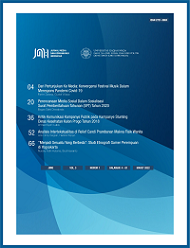Analisis Intertekstualitas di Relief Candi Prambanan Makna Fisik Wanita
Ade Onny Siagian(1*), Hadion Wijoyo(2)
(1) Universitas Bina Sarana Informatika
(2) STMIK Dharmapala Riau, Indonesia
(*) Corresponding Author
Abstract
The existence of women, especially regarding their physical beauty and beauty, is not a myth found in works of art or literature, including those found in temple reliefs. Many temple reliefs in Indonesia depict women and their exoticism, both physically and their activities and position in society. Prambanan Temple is a temple that is known to be closely related to the figure of a beautiful woman named Roro Jongrang who occupies the main statue. In addition to the main statue, on the reliefs of the walls of Prambanan Temple there are also reliefs about other women. This relief is a text that describes women and their existence. This study seeks to explore and interpret the physical woman on the wall reliefs of Prambanan Temple. The research was conducted by using semiotic-semanalytic analysis of Juli Kristeva. The results of the intertextual research show that almost all of the women's physical relief panels at Prambanan Temple are constructed to read the signs on the reliefs as a text, so that the story or story conveyed can be easily recognized and understood. The meaning of genotext in the context of women on temple wall reliefs who appear without a physical cover or naked is a common thing or a habit in society based on geographical and social conditions. The upper physical nudity of women at that time did not affect the views of the people around, especially men. Because women are chosen not based on their body shape but other attractions that are sometimes mystical. The meaning of phenotext, women who appear naked has a negative meaning and leads to pornography, can cause unlimited male attraction, can become victims of sexual crimes, and can even be in contact with the law.
Keywords
Full Text:
PDFReferences
Abdullah, S. N. A. (2020). ANALISIS SEMIOTIKA JULIA KRISTEVA DALAM FILM “SEXY KILLERS” (Pendekatan Semanalisis Hingga Intertekstualitas. AL-WARDAH. https://doi.org/10.46339/al-wardah.v13i2.216
Fernando, M. L. (2019). Gambaran Citra Tubuh pada Wanita Dewasa Awal. Jurnal Ilmiah Psikologi Terapan.
Graduate Student Symposium on Communication Science (GSSC). (2021). Magister Ilmu komunikasi, Fakultas Ilmu Sosial dan Politik, Universitas Gadjah Mada. https://dikom.fisipol.ugm.ac.id/graduate-students-symposium-on-communication-science-2021-hari-pertama/.
Guba, E. G., & Lincoln, Y. S. (1994). Competing Paradigms in Qualitative Research. In N. K. Denzin & Y. S. Lincoln (Eds.). Handbook of Qualitative Research.
Guba, Egong G, & Lincoln, T. S. (1994). Competing paradigms in qualitative research. In N. K. Denzin & Y. S. Lincoln (Eds.), Handbook of qualitative research (pp. 105-117). In Thousand Oaks, CA: Sage.
Hasbullah, M. (2020). Hubungan Bahasa, Semiotika dan Pikiran dalam berkomunikasi. Al-Irfan : Journal of Arabic Literature and Islamic Studies. https://doi.org/10.36835/al-irfan.v3i1.3712
Hidajat, H. (2018). VISUALISASI HEWAN PADA RELIEF RAMAYANA. Titik Imaji. https://doi.org/10.30813/.v1i1.1089
Kristeva, J., Moro, M. R., Ødemark, J., & Engebretsen, E. (2018). Cultural crossings of care: An appeal to the medical humanities. Medical Humanities. https://doi.org/10.1136/medhum-2017-011263
Lelono, H. (1996). Kualitas Pentahtaan Relief Di Kompleks Candi Prambanan. Berkala Arkeologi. https://doi.org/10.30883/jba.v16i2.753
Light, D. W., Berger, P. L., & Luckmann, T. (1967). The Social Construction of Reality: A Treatise in the Sociology of Knowledge. Sociological Analysis. https://doi.org/10.2307/3710424
Lubis, A. A. (2021). Analisis Semiotika Charles Sanders Peirce pada sampul majalah Tempo edisi satu perkara seribu drama. IKRA-WITH Humaniora.
Mukhtar, U. (2018). ISU GENDER DAN UPAYA MENEGAKKAN KEADILAN SOSIAL. Wahana Karya Ilmiah Pendidikan.
Onny Siagian, A. (2020). CHARACTER BUILDING RELASI DALAM KEHIDUPAN BERAGAMA DAN BERSOSIAL (V. Meilinda & A. S. Wijaya (eds.); 1st ed.). Syntax Computama. https://play.google.com/store/books/details/Ade_Onny_Siagian_S_H_M_H_M_M_M_A_P_M_I_Kom_l_CHARA?id=daYQEAAAQBAJ
Pradopo, R. D. (1999). Semiotika: Teori, Metode, Dan Penerapannya Dalam Pemaknaan Sastra. Jurnal Humaniora.
Purwanti, C. (2020). EKSISTENSI BAHASA DALAM KOMUNIKASI INTERPERSONAL: SEBUAH PENDEKATAN INTERDISIPLINER [LANGUAGE EXISTENCE IN INTERPERSONAL COMMUNICATION: AN INTERDISCIPLINARY APPROACH]. Polyglot: Jurnal Ilmiah. https://doi.org/10.19166/pji.v16i2.2261
Purwanti, S. D., & Daryono, D. (2020). TRANSFORMASI RELIEF CANDI PRAMBANAN DALAM KARYA TUBUH RITUS TUBUH OLEH ANGGONO KUSUMO WIBOWO. Greget: Jurnal Pengetahuan Dan Penciptaan Tari. https://doi.org/10.33153/grt.v19i1.3186
Riyani, M. (2015). Local Genius Masyarakat Jawa Kuno Dalam Relief Candi Prambanan. Jurnal Seuneubok Lada.
Setiawan, D. (2018). Evaluasi 3D Texturing Process Pada Bentuk Dinding Bangunan Bersejarah Candi Cetho. DoubleClick: Journal of Computer and Information Technology. https://doi.org/10.25273/doubleclick.v2i1.2496
Soedjono, S. (2015). Creative by Way of Adaption: Ramayana Relief of Prambanan Temple. Journal of Urban Society’s Arts. https://doi.org/10.24821/jousa.v2i2.1447
Wijaya, H. Y. (2015). Memetakan Tubuh, Gender, dan Seksualitas dalam Kajian Queer. Jurnal Perempuan.
Article Metrics
Refbacks
- There are currently no refbacks.
Copyright (c) 2022 Jurnal Media dan Komunikasi Indonesia
| Jurnal Media dan Komunikasi Indonesia (Online ISSN 2721-396X) is published by the Department of Communication Science (DIKOM), Faculty of Social Science and Political Science (FISIPOL), Gadjah Mada University |












